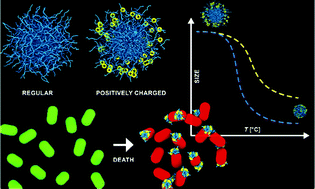Stimuli-responsive microgels with cationic moieties: characterization and interaction with E. coli cells†
Abstract
Stimuli-responsive microgel copolymer networks with ionizable functional groups have important applications for encapsulation of drugs, peptides, enzymes, proteins, or cells. Rational design of such networks can be based on characterization of stimuli-induced volume phase transition and spatial distribution of neutral and charged monomer units in crosslinked polymer chains. In this work we successfully synthesized poly(N-vinylcaprolactam-co-1-vinyl-3-methylimidazolium) (poly(VCL-VIM+)) microgels carrying permanent positive charges and demonstrate that 1H high-resolution NMR spectroscopy in combination with transverse (T2) magnetization relaxometry allows investigating separately the behavior of each functional group in the microgel network. The information about comonomer transition temperatures, width of transition, and change in transition entropy were reported and correlated with the concentration of charged functional groups and resulting electrophoretic mobility. A two-state approach was used to describe the temperature-induced volume phase transition separately for neutral and charged polymer segments. The core–corona architecture specific to each functional group was detected revealing that the charged methylated vinylimidazolium groups (VIM+) are concentrated mainly in the corona of the microgel. These biocompatible PVCL-based microgels functionalized with permanent positive charges are shown to serve as an antibacterial system against Gram-negative E. coli strains, due to the positive charge of the incorporated VIM+ comonomer in the polymer network.



 Please wait while we load your content...
Please wait while we load your content...